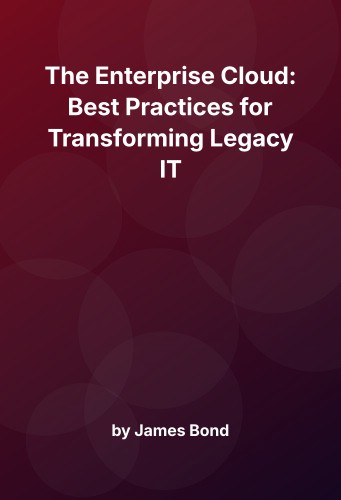Summary
The Enterprise Cloud by James Bond is a comprehensive guide to modernizing legacy IT systems and transforming them into agile, secure, and efficient cloud environments. Unlike consumer-oriented cloud narratives, this book focuses on large enterprises, where cloud adoption is complicated by scale, regulatory requirements, legacy dependencies, and cultural inertia.
Bond draws on decades of IT leadership experience to outline a clear path forward for CIOs, enterprise architects, and transformation leads. His framework includes strategy, technical design, governance, security, financial modeling, and operational alignment.
Why Enterprise Cloud Matters
Enterprises rely on complex legacy systems that are often difficult to scale, secure, and maintain. Cloud offers a solution—but not through a simple lift-and-shift. Bond argues that successful enterprise cloud adoption requires architectural rethinking, cultural change, and rigorous governance.
The cloud is not just another data center. It offers:
- On-demand scalability
- Consumption-based pricing
- Global reach
- Integrated security
- Innovation at speed
But these benefits are only realized with thoughtful planning.
Cloud Strategy Foundations
Bond begins by defining the foundational principles of cloud strategy:
- Align cloud initiatives with business outcomes
- Prioritize agility and innovation over cost-savings alone
- Treat cloud as an operating model, not a location
- Choose the right cloud service model: IaaS, PaaS, SaaS
He emphasizes that cloud is a means to accelerate business capability—not just an IT refresh.
Cloud Operating Models
A successful enterprise cloud requires a defined operating model that includes:
- Cloud governance: Policies, roles, and processes
- Landing zones: Pre-configured cloud environments
- Automation: Infrastructure as code (IaC)
- Security integration: Identity, encryption, logging
- FinOps: Cost transparency and control
Bond outlines how to stand up a Cloud Center of Excellence (CCoE) to enforce standards and best practices across distributed teams.
Migration Approaches
Not all workloads should move to the cloud, and not all at once. Bond categorizes migration strategies into:
- Rehost (Lift-and-Shift): Move without modification
- Refactor: Modify to take advantage of cloud benefits
- Replatform: Change the underlying platform (e.g., from VMs to containers)
- Rebuild: Completely re-architect as cloud-native
- Retire: Decommission redundant systems
- Retain: Leave some workloads on-prem temporarily
A portfolio assessment is crucial before selecting migration paths.
Architecture Patterns
Enterprise architecture must evolve in the cloud. Bond discusses key patterns:
- Microservices: Increase agility, reduce blast radius of failures
- Containers and Kubernetes: Standardize deployment
- Service Mesh: Enhance observability and security between services
- Serverless: Reduce operational overhead for event-driven workloads
- Data Lake and Lakehouse: Centralized analytics at scale
Cloud-native architectures must be designed for failure, latency, and rapid change.
Security and Compliance
Bond dedicates significant focus to security, asserting that the cloud can be more secure than on-premise environments if configured correctly.
Principles include:
- Least privilege access
- Zero trust networking
- Continuous compliance checks
- Encryption by default
- Managed secrets and key rotation
Compliance in regulated industries (e.g., healthcare, finance) is achievable with automation and shared responsibility models.
Governance and Policy
Cloud governance prevents chaos. Bond recommends:
- Establishing guardrails via policy-as-code (e.g., AWS SCPs, Azure Policies)
- Defining accountability (RACI) across stakeholders
- Integrating governance with CI/CD pipelines
- Using tagging and automation for auditability
Governance should enable velocity, not hinder it.
Cost Optimization and FinOps
Cloud costs can spiral out of control if unmanaged. Bond introduces FinOps as the discipline of financial accountability for cloud usage.
Key practices include:
- Resource tagging for chargeback/showback
- Rightsizing and autoscaling
- Reserved and spot instance planning
- Budget alerts and anomaly detection
FinOps blends finance, engineering, and operations into a shared cloud financial culture.
DevOps and Continuous Delivery
Cloud platforms support modern software delivery. Bond promotes:
- Continuous integration and deployment (CI/CD)
- Infrastructure as code (Terraform, CloudFormation)
- Blue/green and canary deployments
- Immutable infrastructure patterns
These practices reduce errors, speed up delivery, and support secure change.
Building a Cloud Team
People are critical to success. Bond defines roles such as:
- Cloud architect
- Site reliability engineer (SRE)
- DevOps engineer
- Cloud security analyst
- Product manager
Upskilling existing staff and creating clear ownership across teams is essential.
Multi-Cloud and Hybrid Strategies
Enterprises rarely operate in a single cloud. Bond explores:
- Benefits of multi-cloud (resilience, negotiation leverage)
- Risks (tooling complexity, skill fragmentation)
- Hybrid cloud for regulated or latency-sensitive workloads
He advises minimizing complexity unless multi-cloud has clear ROI.
Measuring Success
KPIs for cloud transformation include:
- Time to provision infrastructure
- Deployment frequency
- Change failure rate
- Cost per transaction or service
- Customer satisfaction and business impact
Dashboards should unify business and technical metrics.
Case Studies
Bond includes anonymized examples from:
- A global bank modernizing customer onboarding via cloud APIs
- A retail chain reducing IT costs 30% by moving workloads to the cloud
- A pharmaceutical firm enabling real-time analytics across R&D functions
These illustrate common patterns of success—and failure.
Organizational Culture
Cloud transformation requires culture change:
- From project to product mindset
- From centralized control to empowered teams
- From stability-only to innovation + resilience
Leaders must model the behaviors they want to scale.
The Cloud-First Enterprise
Bond concludes by describing the traits of a mature cloud enterprise:
- Autonomous product teams
- Self-service infrastructure
- Cloud-native security posture
- Data-driven decisions
- Rapid experimentation
The destination is not just “in the cloud” but “of the cloud”—operating at digital speed and scale.
Why This Book Matters
The Enterprise Cloud fills the gap between cloud hype and enterprise reality. It blends strategy, engineering, and governance into a practical manual for leaders navigating transformation. Bond’s vendor-neutral perspective and structured methodology make it valuable for any large organization tackling modernization.
TL;DR
James Bond’s The Enterprise Cloud provides a clear roadmap for transforming legacy IT into agile, cloud-native infrastructure. It balances security, performance, and cost, showing how to modernize systems, empower teams, and unlock digital innovation at enterprise scale.

